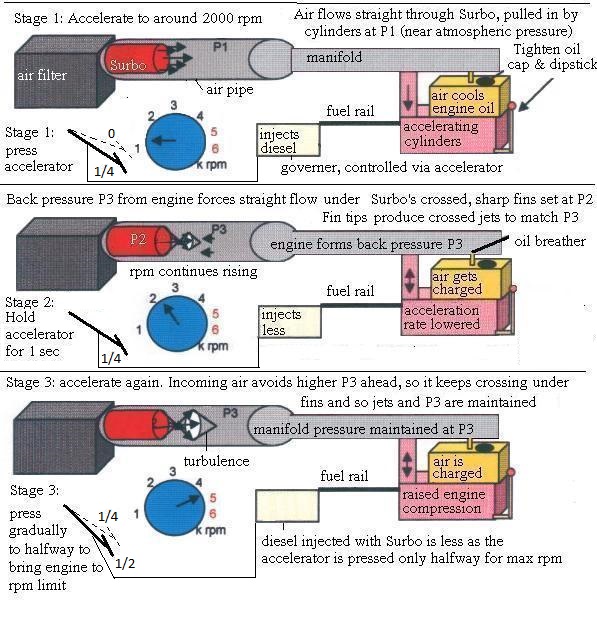HOME









MOTORCYCLE LIST
CAR LIST BY BRANDS
⋮ SITE MAP (below)
Advantages of Surbo for diesel engines
The Surbo ensures that less partially burnt diesel is released from the diesel engine because the accelerator is pressed less for the same power. This will either mean less diesel smoke for older diesel vehicles, or less clogging in thoroughly filtered Euro 4 or 5 vehicles. This will mean less downtime required for programmed self-cleaining of soot within the exhaust system, and less risk of clogged sensors or an expensive replacement of an uncleanable particulate filter. This is especially important for operators who run short trips with the engines not properly heated up and burning diesel incompletely. Fuel saved will be about 10 percent.
How Surbo Works For Diesel Vehicles
The sketch below explains how the Surbo works on a diesel vehicle:
Stage 1: `Accelerate: you must be accelerating, and not try to activate the Surbo system from a constant rpm, say 2000 rpm. For higher gears or greater loads, you can try it at a slightly higher rpm. (For heavier vehicles, which may have an rpm range of just 3000 rpm, aim proportionately lower).
Stage 2: ^P3, the back pressure due to the temporarily decelerating cylinders, causes the straight flow through the Surbo to turn into the lower-pressure area under the fins towards their pointed ends, and crossed jets are formed at their sharp tips, resulting in higher air pressure. At the same time when the accelerator is held to generate this P3, the vortex formed within the Surbo due to cross jetting increases air flow to keep vehicle accelerating.
Stage 3: As the accelerator is pressed slightly more again, the air keeps crossing due to the higher pressure P3 ahead, and so the jets stay to maintain the higher air pressure. Compressed air gives more power, so only a smaller accelerator input is required. This increases driving pleasure. It also saves fuel as the fuel injected will be less.
If no rpm meter is fitted, the speedometer can be used as a rough guide. The engine rpm can be calculated by speed divided by mph/1000 rpm or kph/1000 rpm. Check your vehicle handbook for gearbox info.

Related pages:
How to increase engine power for diesel vehicles
Surbo System's energy analysis for diesel engines
Videos:

Watch the video above showing how an engine revs with Surbo. Or watch it with the How it works page.

Above: video of Volvo XC90 T8 with Surbo, sprinting to 130 kph.

Above: video of Volvo XC90 T8 with Surbo, sprinting to 211 kph.

Above: video of Volvo XC90 T8 with Surbo, sprinting to 224 kph.
Site Map:
TESTIMONIALS:

BENEFITS:
More torque and BHP (dyno test)
Instant throttle response
10% fuel saving on average
Quick revving (1/2 throttle to RPM limit)
Easy auto gear kickdown
Faster acceleration
More power uphill
Higher top speed
More overtaking power
Lifetime warranty
Vehicle inspection compliance
VEHICLES FITTED BY TYPE:
Automatic
CVT
Petrol turbo
Diesel/ turbodiesel
Hybrid
Supercharged
Manual
Natural gas
Motorcycles
How Surbo feels (by car type)
 Installation Photos
Installation Photos
SURBO VERSIONS:
What's Surbo ($99)?
Twin Surbo ($160)
Surbo5 ($120) for bigger cars
TECHNICAL INFO:
How Surbo works
With and without Surbo
How Surbo can be used
Higher air compression
Reduced turbo lag
Less diesel smoke
Improved engine vacuum
Less engine knock
Longer engine life
Surbo vs other accessories
FAQ
SURBO FOR RACING:
First place (India)
Runner up (S'pore race)
Gokart Racing
ABOUT US:
Company history
Surbo's origin
Reducing CO2 emissions
During the installation
Aftersales/ removal
Transfer (fits most cars)
Refund policy
Other applications for Surbo
 CHAT (+65 9857 2661)
CHAT (+65 9857 2661)
If you are using a handphone to read this, you can press the above CHAT link to either call us, or to save our number to your contacts, and then you can message us by clicking the WhatsApp icon below.



HOME PAGE
Remember to bookmark this page and come back to read more!
Go back to the top!



















